Polar Bonds vs. Nonpolar Bonds — What's the Difference?
Edited by Tayyaba Rehman — By Fiza Rafique — Published on December 5, 2023
Polar Bonds result from an uneven distribution of electron density, creating a dipole. Nonpolar Bonds have an equal distribution, lacking a dipole.

Difference Between Polar Bonds and Nonpolar Bonds
Table of Contents
ADVERTISEMENT
Key Differences
Polar Bonds occur when two atoms share electrons unequally, leading to a molecule with electrically charged areas. This means that one end of the molecule carries a slight positive charge while the other end has a slight negative charge. Nonpolar Bonds, on the other hand, happen when atoms share electrons more equally. There's no significant difference in electronegativity between the two atoms, resulting in a bond that's electrically neutral.
Polar Bonds often result in molecules with properties that reflect their polar nature. Such molecules tend to have higher boiling points, melting points, and are generally soluble in polar solvents like water. Nonpolar Bonds give rise to molecules that have more uniform charge distribution. Consequently, nonpolar molecules tend to have lower boiling and melting points and are typically insoluble in polar solvents but soluble in nonpolar solvents.
Polar Bonds can be found in many everyday substances, such as water. In a water molecule, the oxygen atom is more electronegative than the hydrogen atoms, leading to a polar bond. Nonpolar Bonds are present in molecules like hydrogen gas, where both atoms have identical electronegativities, ensuring equal sharing of electrons.
Polar Bonds and Nonpolar Bonds play crucial roles in chemistry and biology. The interactions between polar molecules often drive biological processes, while nonpolar interactions are essential in the formation of cell membranes and fat storage. Understanding the difference between these bond types helps predict how molecules will interact and behave in various environments.
Comparison Chart
Electron Distribution
Uneven, leading to charged areas.
Even, with no significant charge differences.
ADVERTISEMENT
Examples
H2O, HF
H2, O2
Solubility
Typically soluble in polar solvents like water.
Typically soluble in nonpolar solvents.
Boiling/Melting Points
Generally higher due to stronger intermolecular forces.
Generally lower.
Importance
Drive many biological processes.
Key in cell membrane formation, fat storage.
Compare with Definitions
Polar Bonds
Polar Bonds lead to molecules having a dipole, with distinct positive and negative regions.
In HCl, the Polar Bond makes chlorine slightly negative.
Nonpolar Bonds
Nonpolar Bonds are commonly found in fats and oils.
The fatty acid chains in soap have Nonpolar Bonds, helping remove oil and grease.
Polar Bonds
Polar Bonds arise from an unequal sharing of electrons between atoms.
Water's cohesion is due to its Polar Bonds.
Nonpolar Bonds
Nonpolar Bonds lead to molecules without a significant dipole.
Methane has Nonpolar Bonds, making it non-reactive with polar substances.
Polar Bonds
Polar Bonds can create molecules with unique solubility and boiling point properties.
Due to its Polar Bonds, ethanol mixes well with water.
Nonpolar Bonds
Nonpolar Bonds occur when electrons are shared equally between atoms.
In a nitrogen gas molecule, Nonpolar Bonds are present.
Polar Bonds
Polar Bonds result from a difference in electronegativity between bonding atoms.
HF has a Polar Bond because fluorine is more electronegative than hydrogen.
Nonpolar Bonds
Nonpolar Bonds result when bonding atoms have similar electronegativities.
In an oxygen molecule, the bond is Nonpolar because of identical electronegativities.
Polar Bonds
Polar Bonds often produce molecules that engage in hydrogen bonding.
DNA strands are held together by hydrogen bonds due to their Polar Bonds.
Nonpolar Bonds
Nonpolar Bonds give rise to molecules that don't mix well with polar substances.
Due to its Nonpolar Bonds, oil doesn't mix with water.
Common Curiosities
Why are molecules with Nonpolar Bonds often gases at room temperature?
They have weaker intermolecular forces, leading to lower boiling points.
What causes Polar Bonds?
Polar Bonds result from an unequal sharing of electrons due to a difference in electronegativity.
How does polarity affect solubility?
Polar molecules tend to dissolve in polar solvents, while nonpolar molecules dissolve in nonpolar solvents.
Are Nonpolar Bonds found in water?
No, water contains Polar Bonds due to the electronegativity difference between hydrogen and oxygen.
Can Nonpolar Bonds create dipoles?
Nonpolar Bonds don't create permanent dipoles but can have temporary induced dipoles.
Can a molecule have both Polar Bonds and Nonpolar Bonds?
Yes, a molecule like CCl4 has Polar Bonds between carbon and chlorine but is overall nonpolar due to its symmetry.
Are Polar Bonds stronger than Nonpolar Bonds?
The bond strength depends on the atoms involved, not just polarity. However, molecules with Polar Bonds often have stronger intermolecular forces.
What's a real-life example of a molecule with Polar Bonds?
Water (H2O) is a common molecule with Polar Bonds.
Is it possible for a molecule with only Nonpolar Bonds to be polar?
No, if a molecule only has Nonpolar Bonds, it's nonpolar. However, a molecule can have Polar Bonds and still be nonpolar overall if it's symmetrical.
Why don't oil and water mix?
Oil has Nonpolar Bonds, making it nonpolar, while water has Polar Bonds, making it polar. Polar and nonpolar substances don't mix well.
Are all diatomic molecules nonpolar?
Not necessarily. Diatomic molecules like HCl are polar due to electronegativity differences.
How are Nonpolar Bonds relevant in biology?
Nonpolar Bonds are crucial in forming cell membranes, storing fats, and more.
Do Nonpolar Bonds result in charged molecules?
No, Nonpolar Bonds lead to electrically neutral molecules due to even electron sharing.
Do Polar Bonds impact boiling points?
Yes, molecules with Polar Bonds often have higher boiling points due to stronger intermolecular forces.
What instrument can help determine if a molecule has Polar or Nonpolar Bonds?
Spectroscopy, especially infrared (IR) spectroscopy, can help determine bond polarity.
Share Your Discovery

Previous Comparison
Proforma Invoice vs. Invoice
Next Comparison
Binary Acids vs. Ternary AcidsAuthor Spotlight
Written by
Fiza RafiqueFiza Rafique is a skilled content writer at AskDifference.com, where she meticulously refines and enhances written pieces. Drawing from her vast editorial expertise, Fiza ensures clarity, accuracy, and precision in every article. Passionate about language, she continually seeks to elevate the quality of content for readers worldwide.
Edited by
Tayyaba RehmanTayyaba Rehman is a distinguished writer, currently serving as a primary contributor to askdifference.com. As a researcher in semantics and etymology, Tayyaba's passion for the complexity of languages and their distinctions has found a perfect home on the platform. Tayyaba delves into the intricacies of language, distinguishing between commonly confused words and phrases, thereby providing clarity for readers worldwide.











































